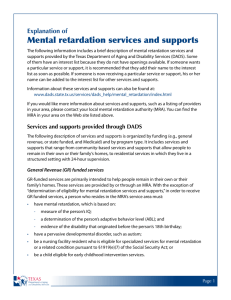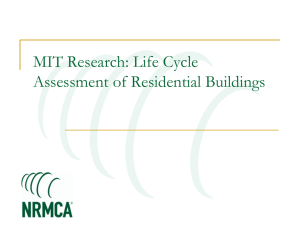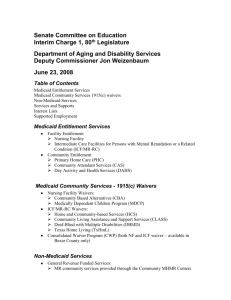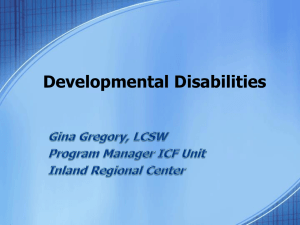House Select Committee on Services for Individuals Eligible for
advertisement
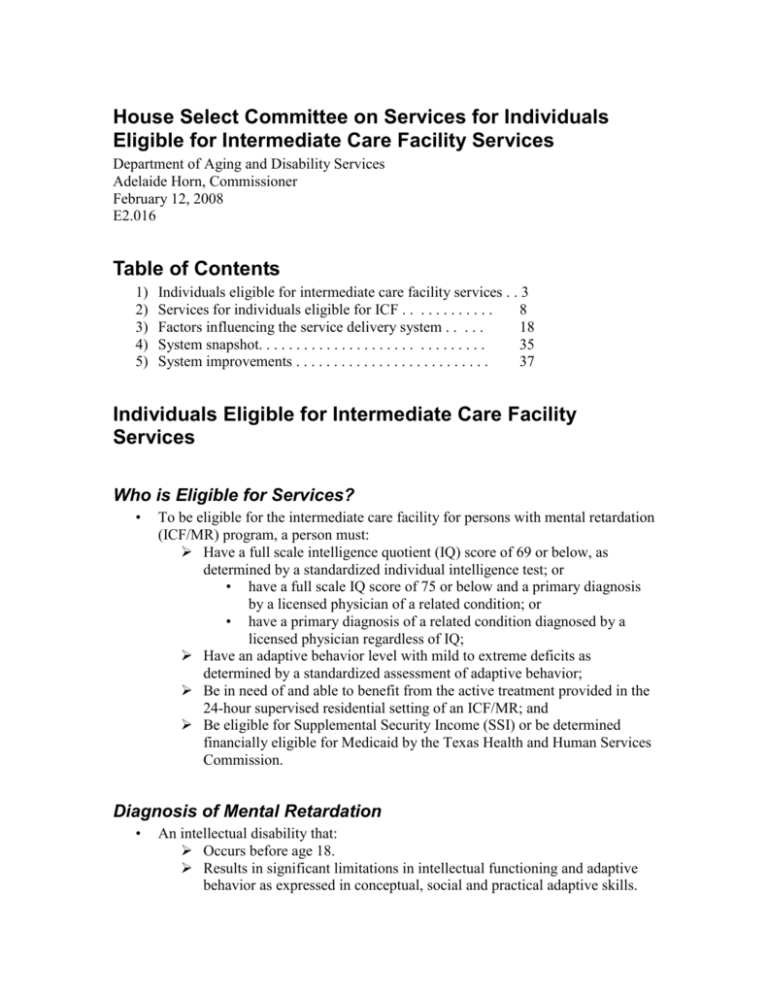
House Select Committee on Services for Individuals Eligible for Intermediate Care Facility Services Department of Aging and Disability Services Adelaide Horn, Commissioner February 12, 2008 E2.016 Table of Contents 1) 2) 3) 4) 5) Individuals eligible for intermediate care facility services . . 3 Services for individuals eligible for ICF . . . . . . . . . . . . 8 Factors influencing the service delivery system . . . . . 18 System snapshot. . . . . . . . . . . . . . . . . . . . . . . . . . . . . . 35 System improvements . . . . . . . . . . . . . . . . . . . . . . . . . . 37 Individuals Eligible for Intermediate Care Facility Services Who is Eligible for Services? • To be eligible for the intermediate care facility for persons with mental retardation (ICF/MR) program, a person must: Have a full scale intelligence quotient (IQ) score of 69 or below, as determined by a standardized individual intelligence test; or • have a full scale IQ score of 75 or below and a primary diagnosis by a licensed physician of a related condition; or • have a primary diagnosis of a related condition diagnosed by a licensed physician regardless of IQ; Have an adaptive behavior level with mild to extreme deficits as determined by a standardized assessment of adaptive behavior; Be in need of and able to benefit from the active treatment provided in the 24-hour supervised residential setting of an ICF/MR; and Be eligible for Supplemental Security Income (SSI) or be determined financially eligible for Medicaid by the Texas Health and Human Services Commission. Diagnosis of Mental Retardation • An intellectual disability that: Occurs before age 18. Results in significant limitations in intellectual functioning and adaptive behavior as expressed in conceptual, social and practical adaptive skills. • • • Is diagnosed through the use of standardized tests of intelligence and adaptive behavior. Common causes include: Certain illnesses experienced by the mother during pregnancy, such as fetal alcohol syndrome or rubella Chromosomal abnormalities, such as Down Syndrome and Fragile X Syndrome Problems at birth, such as prematurity, low birth weight or birth injuries Problems after birth, such as meningitis, head injury or exposure to environmental toxins Mental retardation ranges from mild to profound: Mild – IQ is typically between 50 and 70 Moderate – IQ is typically between 35 and 49 Severe – IQ is typically between 20 and 34 Profound – IQ is typically below 20 Secondary conditions are often associated with mental retardation, for example: Seizure disorders Physical or developmental disabilities, such as Cerebral Palsy Medical fragility Hearing impairment Visual impairment Mental illness Attention deficit hyperactivity disorder (ADHD) Diagnosis of Related Condition • A related condition is a severe or chronic disability that: Manifests before age 22 Results in substantial functional limitations in three of six major life activities: self-care, language, learning, mobility, self-direction, capacity for independent living Includes many diagnoses, for example: • Seizure disorders such as epilepsy • Autism spectrum disorders • Spina bifida • Cerebral Palsy May have many causes or an unknown cause. May involve conditions that exist in combination with others. Services for Individuals Eligible for ICF/MR Services Medicaid State Plan (Entitlement) ICF/MR 1915 (c) Waivers (Non-Entitlement) CLASS HCS TxHmL DBMD CWP GR Funded Services Medicaid Entitlement • • Medicaid-eligible individuals who meet level of care and other requirements have a federal entitlement to receive long-term care in various institutional settings. ICFs/MR are entitlement services. These include: Community ICFs/MR State schools What is an ICF/MR? • • • • • • A residential facility providing services to four or more individuals with mental retardation or a related condition. Examples of services provided include: Supervision and support 24-hours per day/7 days a week; Habilitation (assistance developing and refining skills for community life/work) Nursing and prescription services Skills training Speech, occupational and physical therapy Adaptive aids, such as a cane, wheelchair, or appliance to assist in eating when holding a utensil is difficult. ICFs/MR are operated by both private and public entities. There are three sizes of ICFs/MR: Large facility – 14 or more beds (includes state schools and state centers) Medium facility – 9 to 13 beds Small facility – 8 or fewer beds Active treatment, the core requirement for certification as an ICF/MR, is the aggressive, consistent implementation of a program of specialized and generic training, treatment and health services. Individual ICF/MR providers may set criteria for admission to their facilities to ensure the health and safety and appropriate provision of services to all residents. For example: State schools serve those with severe or profound mental retardation and people with mental retardation who are medically fragile or have behavioral issues. A provider may determine a 6-bed home only will serve females. Non-Entitlement Services – 1915(c) Waivers • • Waiver programs allow states flexibility to limit: Scope of eligibility Geographical location in which services are provided Scope of services Amount of services Number of people served An individual can be enrolled in only one waiver program. What is an ICF/MR waiver? • ICF/MR waiver programs for individuals eligible for ICF/MR services include: Home and Community-based Services (HCS) Community Living Assistance and Support Services (CLASS) Deaf-Blind/Multiple Disabilities Program (DBMD) Texas Home Living (TxHmL) Consolidated Waiver Program (CWP) • The legislature sets the funding level for the waiver programs. DADS maintains an interest list for each program with the names of individuals who have expressed an interest in receiving that program’s services and supports. Non-Entitlement Services – GR Funded Services • • MR Community Services provided through the Community MHMR Centers include: Employment services Day habilitation – services provided away from an individual’s home to help develop and refine the skills necessary to live and work in the community Therapies such as nursing; social work; and occupational, speech, and physical therapy Respite Community Supports - activities in an individual’s home or at community locations to facilitate the individual’s ability to perform activities of daily living MR Community Residential Services are 24-hour residential arrangements. Rider 19, 80th session, 2007, directs DADS to refinance GR-funded residential services for persons with mental retardation with Medicaid funding, through waiver programs or, if necessary, the ICF/MR program. Fewer than 50 individuals currently receive GR-funded MR residential services. Providers of Services • • • Private providers Community MHMR Centers The State of Texas Mental Retardation Authorities • • • Each county in Texas has a designated local mental retardation authority (MRA) that assists individuals in accessing services and supports. Community MHMR Centers function as the MRA in all counties except Bexar County, in which the Alamo Area Council of Government serves as the MRA. Mental Retardation Authorities: Provide explanations of the services and supports for which individuals may be eligible Conduct eligibility determinations and Determination of Mental Retardation assessments Provide pemanency planning for children Provide the community living options information process for adult residents in state schools Provide service coordination Conduct local planning, ensuring stakeholder involvement Factors Influencing the Service Delivery System Community MHMR Center System • • • The Texas Community MHMR Center System was authorized in 1965. Publicly funded community-based mental retardation services began to evolve. Today there are 39 Community MHMR Centers across Texas. Medicaid • Medicaid, established in 1967, is a jointly funded state-federal program and is administered in Texas by the Health and Human Services Commission. ICF/MR Services were added to Medicaid State Plan in 1972 State Schools were certified as ICFs/MR in 1974 Lelsz vs. Kavanagh • The Lelsz vs. Kavanagh lawsuit was filed in 1974 by five families on behalf of individuals residing in Texas state schools. The lawsuit: Alleged a failure to meet minimal constitutional standards for individuals with mental retardation who resided in state facilities • • • Sought improvements and changes related to training and habilitation, inappropriate institutionalization and expansion of community services. Key elements of the 1991 settlement agreement were: The closure of two state schools The movement of individuals from state schools to community settings at a rate of 600 persons within two years Over the four-year period of the settlement agreement, 1,286 individuals moved from state schools to community settings. The Lelsz lawsuit was dismissed in November 1995 based on a determination that the state had fulfilled the terms of the 1991 settlement agreement. SB 700, 65th Legislature, 1977 Persons with Mental Retardation Act • • Provides that people with mental retardation have the rights, benefits, and privileges guaranteed by the constitutions and laws of the United States and Texas. Further specifies particular rights including right to: Be protected from exploitation and abuse; Adequate treatment and habilitative services; Live in the least restrictive setting* appropriate to the individual’s needs and abilities and in a variety of living situations; and A presumption of competency. * The regulations implementing Title II of the Americans with Disabilities Act use the terminology “most integrated setting” instead of “least restrictive setting.” ICF/MR Waiver Program Established • In 1981, Section 1915(c) of the Social Security Act was added to allow the federal government to support states in providing services in the home and community for Medicaid-eligible individuals who would be eligible for services in long-term care institutions. • In 1985, the Texas HCS waiver was authorized. This community-based program offers: • A broader array of choice in type and location of services • A cost-effective alternative to institutionalization SB 257, 70th Legislature, 1987 • SB 257 added Health and Safety Code Section 533.084(d) clarifying that the authority to close or consolidate a state school rests with the legislature: (d) This section does not authorize the department to close or consolidate a facility used to provide mental health or mental retardation services without first obtaining legislative approval. HB 2377, 74th Legislature, 1995 • • • HB 2377 codified the concept of a local mental retardation authority (MRA) to which the state could delegate certain functions, such as planning and resource development and allocation. This legislation recognized the central role of citizen participation in: Planning Evaluating the quality, appropriateness and adequacy of supports and services It established the expectation that each local authority consider public input, costbenefit and client care to ensure consumer choice and the best use of public money in: Assembling a network of providers Determining whether to be a provider of service or to contract that service to another organization Olmstead vs. L.C. • The June 1999 US Supreme Court ruled in Olmstead vs. L.C. that unnecessary institutionalization is a violation of the Americans with Disabilities Act of 1990. • States must provide community-based services for persons with disabilities who would otherwise be entitled to institutional services when: The state’s treatment professionals determine that such placement is appropriate; Affected persons do not oppose such treatment; and Placement can be reasonably accommodated, taking into account the resources available to the state and the needs of others who are receiving state supported disability services. • The ruling directs states to make reasonable modifications in programs and activities, unless the modifications would "fundamentally alter" the nature of services, programs or activities. Promoting Independence • Following the Olmstead decision, Executive Order GWB 99-2 directed the Health and Human Services Commission to: Involve consumers, advocates, providers and relevant state agencies in a comprehensive review of all services and support systems available to individuals with disabilities in Texas. Submit a report of its findings, including recommendations on how Texas can improve its community-based programs for individuals with disabilities. • The first Promoting Independence Plan was submitted to the Governor and state leadership on January 9, 2001. Recommendations addressed: Methods to identify and assess individuals for movement to the community Access to services System capacity Removing service barriers to community support Service coordination SB 367, 77th Legislature, 2001 • • • SB 367 codified many of the recommendations made in the original Promoting Independence Plan, including the living options process designed to promote and ensure awareness of alternative living options for ICF/MR residents. The living options process requires all providers of ICF/MR services to discuss living options with individual residents, legally authorized representatives, and/or family at least annually or upon request. SB 367 codified the task force currently known as the Promoting Independence Advisory Committee. SB 368, 77th Legislature, 2001 Permanency Planning • • • Permanency planning is a philosophy and planning process that focuses on achieving family support for individuals under age 22 by facilitating permanent living arrangements that include an enduring and nurturing parental relationship. Since September 2001, Texas has required permanency planning for all individuals under age 22 who reside in certain “institutions”: ICFs/MR, including state mental retardation facilities; HCS group homes; Another residential arrangement, other than a DFPS foster home, that provides care to four or more unrelated people under age 22. Placement in these settings is considered temporary, and approval for the individual to reside in the institution must be obtained every six months. Executive Order RP -13, Promoting Independence • In April 2002, Governor Rick Perry issued Executive Order RP-13 to further the state’s efforts regarding the Promoting Independence Initiative and communitybased alternatives for individuals with disabilities. For example, the order directed the Health and Human Services Commission to: Review and amend state policies that impede moving individuals from institutions to the community Incorporate the efforts of relevant state agencies to address housing and employment issues Ensure permanency planning for children Implement a selected essential services waiver to provide community services for people waiting for services through the HCS waiver (Texas Home Living). Rider 55, HB 1, 78th Legislature, 2003 • • Rider 55, 78th session, 2003, directed HHSC to study the feasibility of closure and consolidation of state hospitals and state schools. No state facilities were recommended for closure or consolidation. HB 2292, 78th Legislature, 2003 • • HB 2292 set a new direction for improving the delivery of health and human services for Texas by consolidating 12 agencies into five. Created the Department of Aging and Disability Services – merged mental retardation and state school programs of the Department of Mental Health and Mental Retardation, community care and nursing home programs of the Department of Human Services, and aging services of the Texas Department of Aging. SB 27, 80th Legislature, 2007 • • • • Senate Bill 27, 80th Legislature, 2007, included provisions related to the community living options information process for adult residents of state schools. Living options for a state school resident are reviewed 30 days after admission to the state school, at least annually, and upon request by the resident/family members/guardian. Senate Bill 27 directed DADS to delegate to local MRAs the implementation of a Community Living Options Information Process for adult residents at state schools. The community living options information process and tools were developed in conjunction with a broad range of stakeholders as required by the bill. January 2, 2008 - the process was fully operational in accordance with SB 27. HB 2439, 80th Legislature, 2007 • • HB 2439 addressed issues related to provider of last resort and the roles of local mental health and mental retardation authorities (MRAs). Required DADS to ensure that MRAs further the goals of: Providing individuals with information to make informed decisions Respecting the rights of individuals Integrating individuals into the community System Snapshot: FY 1987 and FY 2007 FY 1987 Average Persons Served Per Month FY 1987 ave. Community ICF/MR –persons 6,649 FY 1987 State Schools – 8,134 served per expenditures mo. (in millions) Community ICF/MR State Schools 6,649 8,134 $52.3 $248.3 FY 2007 ave. persons FY 2007 served per expenditures mo. (in millions) 6,608 4,909 $337.7 $473.2 CLASS – DBMD – HCS – 196 Texas Home Living – GR Services – 19,578 Total – 34,557 FY 1987 expenditures (in millions) Community ICF/MR – $52.3 State Schools – $248.3 CLASS – DBMD – HCS – $1.5 Texas Home Living – GR Services – $91.1 Total – $393.2 FY 2007 Average Persons Served Per Month Community ICF/MR -- 6,608 State Schools – 4,909 CLASS – 3,113 DBMD – 138 HCS – 11,796 Texas Home Living – 1,392 GR Services – 13,141 Total – 41,097 FY 2007 expenditures (in millions) Community ICF/MR – $337.7 State Schools – $473.2 CLASS – $103.8 DBMD – $6.3 HCS – $455.2 Texas Home Living – $7.5 GR Services – $92.2 Total – $1,475.9 The costs for state schools include SWICAP (statewide indirect cost allocation plan), DICAP (department indirect cost allocation plan), maintenance and construction costs, employee benefit costs and other federally allowable administrative, medical and overhead costs. Expenditures and numbers served do not include the approximately 100 individuals in CWP. System Improvements State School Improvements • • • • • • • • • • Management Eight new superintendents since October 2005 New leadership in state office Additional operations staff in state office Two new program liaisons New Program Improvement Unit 1,690 new FTEs at state schools to be hired over the biennium, including: A total of 1,211 medical professional and direct care positions (positions such as registered nurses, licensed vocational nurses, occupational and physical therapists, psychologists, MHMR service aides and other medical professional positions) 479 other positions that support state school operations (positions such as food personnel, laundry staff, maintenance employees, receptionists, timekeepers) As of February 6, 2008, 677 of the new positions at state schools were filled. Standardized: Person-directed planning system Values-based culture training Unusual incident trend analysis system Assessment tools for the side effects of medications Rights assessments Improved comprehensive quality enhancement reviews Positive behavior support training and service provision Statewide reduction in restraints and restrictive practices Prevention and management of aggressive behavior Statewide competency-based training is being conducted by Columbus Organization at all state schools Department of Justice – Lubbock SS Investigation • • The Department of Justice released an investigative findings letter on the Lubbock State School in December 2006, based on a site visit in June 2005. DADS: • After receiving notice of DOJ’s intended investigation, hired Columbus Organization as expert consultants Immediately developed and implemented a facility plan to address exit findings Meets weekly with staff from HHSC, Attorney General and Governor’s office Conducts regular briefings for leadership and legislative offices Negotiations with DOJ related to the Lubbock State School are ongoing. Waiver Improvements • • • • • Consumer Directed Services (CDS) gives consumers the option of: Hiring, training, supervising, and firing their service providers; Setting the wages (within guidelines) and benefits for providers. Since 2001, a CDS option has existed for some CLASS services. In December 2007, 1,525 CLASS consumers were participating in CDS. DBMD includes a CDS option for certain services, including respite. On February 1, 2008, DADS began offering a CDS option for some HCS services and the full array of services in TxHmL. During the next year, DADS plans to offer the CDS option for some services in CWP. The 80th Legislature passed DADS Rider 45, which: • Increases the cost limits for six of the Medicaid 1915(c) waiver programs administered by DADS. The new cost limits for CBA, CWP, CLASS, DBMD, and HCS are 200 percent of the cost of institutional services. The new cost limit for MDCP is 50 percent of the cost of institutional services. • Authorizes DADS to use GR funds for the incremental portion of the costs exceeding the waiver limit for individuals who cannot be served safely in an institutional setting and whose needs exceed the waiver cost limits. • Directs DADS to implement utilization management and review practices to ensure individuals receive the appropriate level of services while maintaining compliance with CMS cost effectiveness requirements. • In August 2007, DADS staff met with stakeholders to discuss the potential expansion of DADS’ waiver programs and to identify provider infrastructure issues in preparation for the FY10-11 LAR. Identified issues include: Availability of qualified direct care staff Availability of specialized services providers, for example, occupational, physical and speech therapists Sufficient rate structure Money Follows the Person Demonstration • • • DADS has received final approval for a new $18 million federal initiative that will help Texans who are aging and/or have a disability move back into their communities from institutional settings. Texas will receive an enhanced Medicaid match, an extra 20% in Federal Medical Assistance Percentages (FMAP), for all demonstration participants. One of many initiatives under the demonstration is the voluntary closure of community ICFs/MR with nine or more beds. To facilitate this initiative DADS will: Work with community ICF/MR providers who want to close their facilities and change their business model. Help each individual residing in that facility select a new residential setting. Individuals may choose a community setting or another ICF/MR. Interest Lists • • For FY 06-07, the legislature appropriated $172.5 million (all funds) to serve 4,534 individuals on interest lists for the waivers serving individuals with mental retardation or a related condition. This brought the average number served per month in these waivers at the end of the 06-07 biennium to 17,706. (Total does not include individuals receiving GR-funded services.) For FY 08-09, the legislature appropriated $130.7 million (all funds) to serve 3,278 individuals on the interest lists for the waivers serving individuals with mental retardation or a related condition. The legislature also appropriated (all funds): $10 million to move 180 individuals from large ICFs/MR to the community $6.5 million for community services and supports for 120 children aging out of Child Protective Services conservatorship $14.7 million for 250 individuals to move from state schools to the community
